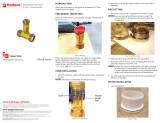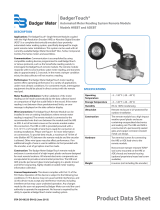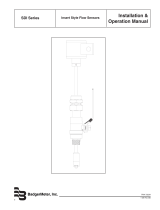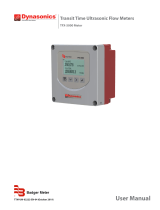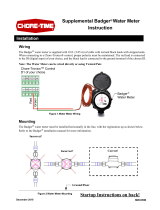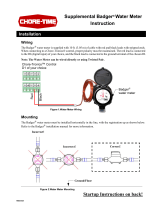
Transmitters
Model 340N2 Btu
XMT-UM-01655-EN-08 (March 2016)
User Manual

Transmitters, Model 340N2 Btu
CONTENTS
Description . . . . . . . . . . . . . . . . . . . . . . . . . . . . . . . . . . . . . . . . . . . . . . . . . . . . . . . . . . . . . . . . . . . . . . . . . . 3
Scope and Purpose . . . . . . . . . . . . . . . . . . . . . . . . . . . . . . . . . . . . . . . . . . . . . . . . . . . . . . . . . . . . . . . . . . . . . 3
Installation. . . . . . . . . . . . . . . . . . . . . . . . . . . . . . . . . . . . . . . . . . . . . . . . . . . . . . . . . . . . . . . . . . . . . . . . . . .3
Mechanical Installation . . . . . . . . . . . . . . . . . . . . . . . . . . . . . . . . . . . . . . . . . . . . . . . . . . . . . . . . . . . . . . . .3
Location . . . . . . . . . . . . . . . . . . . . . . . . . . . . . . . . . . . . . . . . . . . . . . . . . . . . . . . . . . . . . . . . . . . . . . . . . 4
Surface Mount Installation. . . . . . . . . . . . . . . . . . . . . . . . . . . . . . . . . . . . . . . . . . . . . . . . . . . . . . . . . . . . . .4
Din Rail Mounting . . . . . . . . . . . . . . . . . . . . . . . . . . . . . . . . . . . . . . . . . . . . . . . . . . . . . . . . . . . . . . . . . . . 4
Wall Mounting . . . . . . . . . . . . . . . . . . . . . . . . . . . . . . . . . . . . . . . . . . . . . . . . . . . . . . . . . . . . . . . . . . . . . 4
Temperature Sensor Installation . . . . . . . . . . . . . . . . . . . . . . . . . . . . . . . . . . . . . . . . . . . . . . . . . . . . . . . . . . . . . 4
Electrical Installation . . . . . . . . . . . . . . . . . . . . . . . . . . . . . . . . . . . . . . . . . . . . . . . . . . . . . . . . . . . . . . . . . . . . 5
Power Supply Wiring . . . . . . . . . . . . . . . . . . . . . . . . . . . . . . . . . . . . . . . . . . . . . . . . . . . . . . . . . . . . . . . . . 5
Sensor Wiring . . . . . . . . . . . . . . . . . . . . . . . . . . . . . . . . . . . . . . . . . . . . . . . . . . . . . . . . . . . . . . . . . . . . . . 5
Series 200 . . . . . . . . . . . . . . . . . . . . . . . . . . . . . . . . . . . . . . . . . . . . . . . . . . . . . . . . . . . . . . . . . . . . . . . . 5
SDI Series (standard pulse output option) . . . . . . . . . . . . . . . . . . . . . . . . . . . . . . . . . . . . . . . . . . . . . . . . . . . . 5
Other Sensors . . . . . . . . . . . . . . . . . . . . . . . . . . . . . . . . . . . . . . . . . . . . . . . . . . . . . . . . . . . . . . . . . . . . . .5
Temperature Element Wiring . . . . . . . . . . . . . . . . . . . . . . . . . . . . . . . . . . . . . . . . . . . . . . . . . . . . . . . . . . . . 6
Pulse Output Wiring . . . . . . . . . . . . . . . . . . . . . . . . . . . . . . . . . . . . . . . . . . . . . . . . . . . . . . . . . . . . . . . . . .6
Connecting the N2 Bus . . . . . . . . . . . . . . . . . . . . . . . . . . . . . . . . . . . . . . . . . . . . . . . . . . . . . . . . . . . . . . . . 6
Programming . . . . . . . . . . . . . . . . . . . . . . . . . . . . . . . . . . . . . . . . . . . . . . . . . . . . . . . . . . . . . . . . . . . . . . . . .7
Programming the Transmitter. . . . . . . . . . . . . . . . . . . . . . . . . . . . . . . . . . . . . . . . . . . . . . . . . . . . . . . . . . . .9
Metasys Network Setup . . . . . . . . . . . . . . . . . . . . . . . . . . . . . . . . . . . . . . . . . . . . . . . . . . . . . . . . . . . . . . . . . 10
Specications . . . . . . . . . . . . . . . . . . . . . . . . . . . . . . . . . . . . . . . . . . . . . . . . . . . . . . . . . . . . . . . . . . . . . . . .11
Factory Defaults . . . . . . . . . . . . . . . . . . . . . . . . . . . . . . . . . . . . . . . . . . . . . . . . . . . . . . . . . . . . . . . . . . . . . . 12
Page 2 March 2016XMT-UM-01655-EN-08

Description
DESCRIPTION
The Badger Meter Model 340N2 Btu transmitter is an economical, compact device for sub-metering applications using
Johnson Controls Metasys® Network Companion and Facilitator Supervisory Systems.
The Model 340N2 transmitter works in conjunction with a flow sensor and two temperature sensors to calculate thermal
energy by measuring liquid flow and inlet and outlet temperatures in a closed pipe system. The transmitter requires two
10 kΩ thermistors for temperature input. The transmitter can accept the signal from most Badger Meter raw pulse flow
sensors, as well as many other pulse and sine wave devices.
The onboard microcontroller and digital circuitry make precise measurements and produce accurate, drift-free outputs. The
Model 340N2 transmitter is configured using Badger Meter Windows® based programming software. Calibration information
for the flow sensor, units of measurement and output scaling may be preselected or entered in the field. Btu transmitter
information is available when connected to a PC or laptop computer. This information includes real-time flow rate, flow total,
both T1 and T2 temperature probe information, energy rate, and energy total.
The Model 340N2 transmitter features two LED’s to verify input and output signals.
The primary output is the Johnson Controls N2 communications protocol that allows the Model 340N2 transmitter to be
assigned an address and allow all measurement parameters—inlet and outlet temperature, flow rate, flow total, energy rate
and energy total—to be transmitted from as many as 32 units on a single 3-wire RS-485 bus.
The secondary output for the Model 340N2 transmitter is an isolated solid state switch closure that is user programmed for
units of energy or flow. The output pulse width is adjustable from 50 mS…5 sec.
The Model 340N2 transmitter operates on AC or DC power supplies ranging from 12…24 volts.
The compact cast epoxy body measures 3.65 x 2.95 inches (93 x 75 mm) and can be easily mounted in panels, enclosures or
on DIN rails.
A B C D E
1.60 in. 2.95 in. 3.65 in. .88 in. .60 in.
41 mm 75 mm 93 mm 22 mm 15 mm
Figure 1: Model 340N2 dimensions
SCOPE AND PURPOSE
This manual provides instructions for installing and programming the Model 340N2 Btu transmitter.
Page 3 March 2016 XMT-UM-01655-EN-08

Installation
INSTALLATION
Mechanical Installation
The Model 340N2 transmitter can be surface mounted onto a panel, attached to DIN rails using adapter clips or wall mounted
using optional enclosures.
Location
Although the device is encapsulated, all wiring connections are made to exposed terminals. The unit should be protected
from weather and moisture in accordance with electrical codes and standard trade practices.
In any mounting arrangement, the primary concerns are ease of wiring and attachment of the programming cable. The unit
generates very little heat so no consideration need be given to cooling or ventilation.
Surface Mount Installation
The Model 340N2 transmitter can be mounted to the surface of any panel using double-sided adhesive tape or by attaching
fasteners through the holes in the mounting flanges of the unit.
Din Rail Mounting
Optional clips snap onto the mounting flanges allowing the transmitter to be attached to DIN 15, 32, 35 mm DIN rail systems.
Wall Mounting
Optional metal and plastic enclosures are available for the Model 340N2 transmitter. The enclosure is first attached to the wall
using fasteners through its mounting holes.
After wiring, the transmitter may be attached to the enclosure with the terminal headers facing in using the slots in the
mounting flanges. As an alternate mounting arrangement, the Model 340N2 transmitter can be fastened to the box cover
using double-sided adhesive tape.
4.5”
4.50
”
2.00
”
Side
Top
Side
Figure 2: Metal box dimensions
4.60”
4.60
”
2.25”
Side
Top
Side
3.25”
5.125”
Figure 3: Plastic box dimensions
TEMPERATURE SENSOR INSTALLATION
The location of the temperature sensors with regard to the flow sensor is important to the accuracy of the energy calculation.
Temperature sensor T1 must be located closest to the flow sensor. A distance of 5 pipe diameters will give the greatest
accuracy. Always install the temperature sensor downstream of the flow sensor.
Page 4 March 2016XMT-UM-01655-EN-08

Electrical Installation
ELECTRICAL INSTALLATION
All connections to the Model 340N2 transmitter are made to
screw terminals on removable headers.
Power Supply Wiring
The Model 340N2 transmitter requires 12…24 volts AC or DC
to operate. The power connections are made to the ORANGE
header. The connections are labeled beside the header.
Observe the polarity shown on the label.
If a Badger Meter plug in type power supply (Model A-1026 or
A-1028) is used, connect the black/white striped wire to the
terminal marked positive (+) and the black wire to the terminal
marked negative (–).
Figure 4: Side view of typical Series 300 removable connector wiring
OTE:N Included with every Model 340N2 transmitter is a
Model 340N2IK kit containing a screw, lockwasher
and ground lead to connect the transmitter to earth
ground. Connect the earth ground lug of
the Model 340N2 transmitter to a solid earth
ground with as short a wire as possible. This will
help prevent electrical interference from affecting
normal operation.
Figure 5: Sample power supply wiring diagram
Sensor Wiring
All flow sensor types connect to the four terminal header
labeled “Sensor Input”.
Series 200
Connect the red wire to sensor signal (+), black wire to sensor
signal (–) and the bare wire to shield. See Figure 6.
SDI Series (standard pulse output option)
Connect SDI number 3 sensor signal to the Model 340N2
transmitter sensor signal (+) and the SDI number 2 sensor
common terminal to Model 340N2 transmitter sensor signal
(–). Connect the shield terminal of the SDI sensor to the shield
terminal of the Model 340N2 transmitter.
Figure 6: Sample sensor wiring diagram
Other Sensors
The sensor input Power Out terminal supplies nominal 12V DC excitation voltage for three wire sensors. Connect sensor signal
+ and sensor signal – wires to transmitter terminals.
OTE:N The green input LED toggles on and off as sensor pulses are received. With no flow input the LED will remain in its last
state (either on or off).
Page 5 March 2016 XMT-UM-01655-EN-08

Electrical Installation
Temperature Element Wiring
Badger Meter thermistors are not polarity sensitive.
Connect the thermistor closest to the flow sensor of the
Model 340N2 transmitter terminal marked Temp 1 number
3 and number 2. Connect the other thermistor wires to the
transmitter terminal marked Temp 2 number 3 and number 2.
Figure 7: Thermistor wiring diagram
Pulse Output Wiring
The Model 340N2 transmitter has solid state switch output,
rated for a maximum sinking current of 100 mA @ 36V DC. In
most cases the transmitter pulse out (+) will connect to the
input pulse (+) and the pulse out (–) terminal to the input
pulse (–) of the receiving device. The separate two terminal
removable header on the Model 340N2 is labeled Output.
Observe the electrical polarity of the output.
OTE:N When the solid state switch is closed the red output
LED will turn on.
Figure 8: Sample pulse output wiring
Connecting the N2 Bus
Observe polarity when connecting the Model 340N2 transmitter. Connect the N2+, N2- and Ref to the appropriate
connections in the N2 network.
OTE:N The Model 340N2 transmitter default address must be changed before it is introduced into an existing network to
avoid any possible address conflicts. See “Programming” on page 7 programming instructions.
If the transmitter is connected at the end of the N2 network, jumpers W1 and W2 can be shorted for biasing and terminating
of the network. The Model 340N2 biasing circuitry is shown in the diagram in Figure 10.
Figure 9: Sample wiring to N2 network
Figure 10: Biasing circuitry
Page 6 March 2016XMT-UM-01655-EN-08

Programming
PROGRAMMING
Prior to introducing the Model 340N2 transmitter to an N2 network, it needs to be configured for the pipe size and desired
units of measure. In addition, the default network address should be changed to an unused address to avoid any conflicts
with other instruments on the N2 network. Programming the Model 340N2 transmitter is accomplished using Badger Meter
computer software, available at www.badgermeter.com.
1. Load the software on the computer.
2. Connect the Model 340N2 transmitter to the computer using the Badger Meter Model A-302 programming cable. (If the
A-302 programming cable is not available, a B&B Electronics Model 485SD9TB can be used.)
• Connect the RS232 side of the cable to the computer serial COM port. A USB to serial port adapter can be used.
• Connect the RS485 side of the cable to the transmitter RS-485 connector.
3. Connect the transmitter to a power supply.
4. Launch the software application.
5. Select 340 from the Device option in the menu bar and N2 from the Device Type drop-down menu as shown in Figure 11.
6. From the Conguration option in the menu bar, select Set Comm Port. The Comm Settings window opens as shown in
Figure 12.
OTE:N If you need help determining the correct COMM port, go to Windows Control Panel> System> Device
Manager> Ports to find the Comm port.
7. Select the Comm port. Then click OK.
Figure 11: Device 340 N2
Figure 12: Set Comm port
8. Set the transmitter Address. The transmitter must have a unique address to establish communication. The default Address
is 248 when the transmitter is new.
Page 7 March 2016 XMT-UM-01655-EN-08

Programming
• If you know the current transmitter Address, click Change to open the Address window and select the correct
Address from the drop-down menu. See Figure 13. Then click Apply.
• If you do not know the Address of the current transmitter or other devices on the string that might be in conflict,
select N2 Advanced Settings (Figure 14) to open the Advanced N2 Configuration window. Then click Scan to see the
list of known Addresses.
To scan for other devices on the network string, the three wire RS-485 network wires must be added to the Three
Terminal A-301-20 cable connector.
When the Scan is complete, scroll down to see the last assigned Address. Then click the New Address drop-down
menu to select the next Address number for the transmitter, and click Assign. The example in Figure 14 shows 154 is
assigned. Click Exit to close the N2 Advanced Settings window. The new Address number you assigned will display at
the bottom of the screen in the Target N2 Address field. See Figure 15.
OTE:N The “Target N2 Address” must match the current setting in the 340N2. The Address cannot be changed
unless the current Address matches the existing 340N2 Address. If the A-302 cable is used alone, the only
Address found will be the 340N2 itself.
Figure 13: Change Address
Figure 14: Scan Addresses
9. When the Device Type, Comm port and Address have been
properly selected, click the Poll Now button to establish
communication (Figure 15).
The dashes on the screen will be replaced with values.
• Poll Now is used to refresh the screen and update the
values.
• Auto Poll automatically refreshes the screen
approximately every 5 seconds.
OTE:N If Poll Now or Auto Poll are not selected, the
values displayed will not be current.
• Clear Totals can be used to reset the totals to zero.
10. Click the Parameters button to open the Parameters
screen for programming the transmitter. See “Programming
the Transmitter” on page 9 for details.
Figure 15: Poll Now
Page 8 March 2016XMT-UM-01655-EN-08

Programming
Programming the Transmitter
Figure 16: Parameters screen
Program the transmitter using the diagram in Figure 15 as a reference.
1. Select the ow sensor type and enter the K and Oset values. See Note #1.
2. Select the desired temperature sensor units.
3. Select the method of computing the temperature dierential. See Note #2.
4. Select the desired ow rate and total units.
5. Select the desired energy rate and total units.
6. Select the output units per pulse and the pulse width.
7. Click Send to transmit the calibration data to the transmitter.
Other options:
Refresh: Rereads the unit and refreshes the screen with the current transmitter settings. This option will overwrite any
changes not sent to the transmitter.
Defaults: Restores the factory default settings to the screen.
8. Click Exit to close the Parameters screen and return to the main screen.
OTE:N #1 Badger Meter sensors are pulse type sensors. The K and Offset information is printed in the owner’s manual
shipped with the product. Calibration constants for other sensors must be supplied by the manufacturer.
OTE:N #2 Typically the Temperature measured by T1 will be greater than T2 in a heating application, and less than T2 in a
cooling application. The selection of one of these choices will determine if energy calculations are made for heating
only (T1>T2), cooling only (T1<T2), or both (absolute).
OTE:N #3 Filter Coefficients (Advanced) allows adjustment of the flow and energy filters. A scale of 0…10 is used with 10
providing the greatest degree of smoothing. Decreasing the filter setting to less than the default value (5) makes
the readings sensitive to noise. Increasing the filter setting can make computed values slow to respond to legitimate
changes in flow and temperature. Either may affect accuracy.
Page 9 March 2016 XMT-UM-01655-EN-08

Metasys Network Setup
METASYS NETWORK SETUP
To incorporate point data into the Metasys Network and the Metasys Companion Network, the following Point Map
is provided.
NPT
1
NPA
2
UNITS POINT DESCRIPTION RANGE/VALUE NOTES
Binary output (2:4)
BO 01 n/a Reset total 1 = reset totals Note 1
Float data (1:5, 2:5)
ADF 01 gpm (flow rate conv coeff) Flow rate 0– max float
ADF 02
gallons (flow total conv
coeff)
Flow total 0– ((2^32) –1)
ADF 03
kBtu/hr (energy rate conv
coeff)
Energy rate 0– max float
ADF 04 Btu (energy total conv coeff) Energy total 0– ((2^32) –1)
ADF 05 °F or °C Temp1
ADF 06 °F or °C Temp2
ADF 07 n/a Flow rate conversion coefficient 0– max float
ADF 08 n/a Flow total conversion coefficient 0– max float
ADF 09 n/a Energy rate conversion coefficient 0– max float
ADF 0A n/a Energy total conversion coefficient 0– max float
Integer date (1:6, 2:6)
ADI 01 n/a Note 2
1
Network Point Type
2
Network Point Address
OTE:N #1 This point resets flow and energy totals when sent an override of value 1. It will recognize this command, but keep
a value of 0 always.
OTE:N #2 0 = Fahrenheit; 1 = Centigrade
Badger Meter has decided not to implement the change of state feature in the Model 340N2 Btu transmitter. By our decision
not to use this feature, normal Metasys COS (alarm limits for analog values and normal condition for binary) notification will
be defeated. If COS notification is required, it is necessary for the operator to perform the following:
1. Map the specic object(s) requiring COS to a CS object.
2. Dene an AD or BD object with the CS object of the required COS point, as the associated in.
3. Assign alarm limits to the AD.
4. The AD or BD point will only be scanned at a minimum of 30 seconds.
5. The normal state of the BO must be updated (written to) by GPL.
Analog/binary input points that are mapped in directly that do not support COS will never report a change of state condition.
They will report the current value when read, but no alarm notification will occur. A read will only occur if a focus window is
open or a feature requires the current value.
Page 10 March 2016XMT-UM-01655-EN-08

Specications
SPECIFICATIONS
Power
Power Supply Options 12…35V DC ±5%
12…24V AC ±10%
Current Draw 60 mA at 12V DC
Flow Sensor Input
All Sensors
Separate excitation voltage is provided for three wire sensors: 7.9…11.4V DC with 270 Ω
source impedance
Pulse Type Sensors
Signal Amplitude 2.5V DC threshold
Signal Limits Vin < 35V (DC or AC peak)
Frequency 0.4…1.0 kHz
Pull-up To 9.1V DC with 2 kΩ
Sine Wave Sensors
Signal Amplitude 10 mV p-p threshold
Signal Limits Vin < 35V (DC or AC peak)
Frequency 0.4…1.0 kHz
Temperature Sensor Input Two required: 10 kΩ thermistor, 2 wire, type II, 10 kΩ at 77° F (25° C)
Pulse Output
Opto-isolated solid state switch
Operating voltage range 0…±60V (DC or AC peak)
Closed (on) state
Load current, 700 mA max. over operating temperature range
On-resistance, 700 mΩ max. over operating temperature range
Open (off) state Leakage at 70 C <1A at 60V (DC or AC peak)
N2 Output RS-485 output compliant with EIA/TIA-485 standards
Operating Temperature –20…158° F –29…70° C
Storage Temperature –40…185° F –40… 85° C
Weight 4.8 oz with headers installed
Sensor Calibration
Data Industrial Use K and offset values provided in sensor owners manual
Other Sensors Check with factory
Units of Measure
Flow
Rate: gpm, gph, l/sec, l/min, l/hr, ft3/sec, ft3/min, ft3/hr, m3/sec, m3/min, m3/hr
Total: gallons, liters, cubic feet, cubic meters
Energy
Rate: kBtu/min, kBtu/hr, kW, MW, hp, tons
Total: Btu, kBtu, MBtu, kWh, MWh, kJ, MJ
Temperature Units Fahrenheit Centigrade
Programming Requires PC or laptop running Windows® 7, XP or Vista and A302-20 programming kit
Accessories A302-20 programming kit
Page 11 March 2016 XMT-UM-01655-EN-08

Transmitters, Model 340N2 Btu
FACTORY DEFAULTS
Default Values Customer Values
Serial Number n/a
Version n/a
Temperature Units °F
Sensor Type Pulse
K= 1
Offset= 0
Flow Rate Units gpm
Flow Total Units gallons
Energy Rate Units kBtu/hr
Energy Total Units Btu
Energy Calculation absolute
Flow Filter 5
Energy Filter 1
Scaled Pulse Output Units energy
Scaled Pulse Output Units Per Pulse 1
Scaled Pulse Output Pulse Width 100
www.badgermeter.com
Trademarks appearing in this document are the property of their respective entities. Due to continuous research, product improvements and enhancements, Badger Meter reserves
the right to change product or system specications without notice, except to the extent an outstanding contractual obligation exists. © 2016 Badger Meter, Inc. All rights reserved.
The Americas | Badger Meter | 4545 West Brown Deer Rd | PO Box 245036 | Milwaukee, WI 53224-9536 | 800-876-3837 | 414-355-0400
México | Badger Meter de las Americas, S.A. de C.V. | Pedro Luis Ogazón N°32 | Esq. Angelina N°24 | Colonia Guadalupe Inn | CP 01050 | México, DF | México | +52-55-5662-0882
Europe, Middle East and Africa | Badger Meter Europa GmbH | Nurtinger Str 76 | 72639 Neuen | Germany | +49-7025-9208-0
Europe, Middle East Branch Oce | Badger Meter Europe | PO Box 341442 | Dubai Silicon Oasis, Head Quarter Building, Wing C, Oce #C209 | Dubai / UAE | +971-4-371 2503
Czech Republic | Badger Meter Czech Republic s.r.o. | Maříkova 2082/26 | 621 00 Brno, Czech Republic | +420-5-41420411
Slovakia | Badger Meter Slovakia s.r.o. | Racianska 109/B | 831 02 Bratislava, Slovakia | +421-2-44 63 83 01
Asia Pacic | Badger Meter | 80 Marine Parade Rd | 21-06 Parkway Parade | Singapore 449269 | +65-63464836
China | Badger Meter | 7-1202 | 99 Hangzhong Road | Minhang District | Shanghai | China 201101 | +86-21-5763 5412 Legacy Document: 872033
Control. Manage. Optimize.
/
